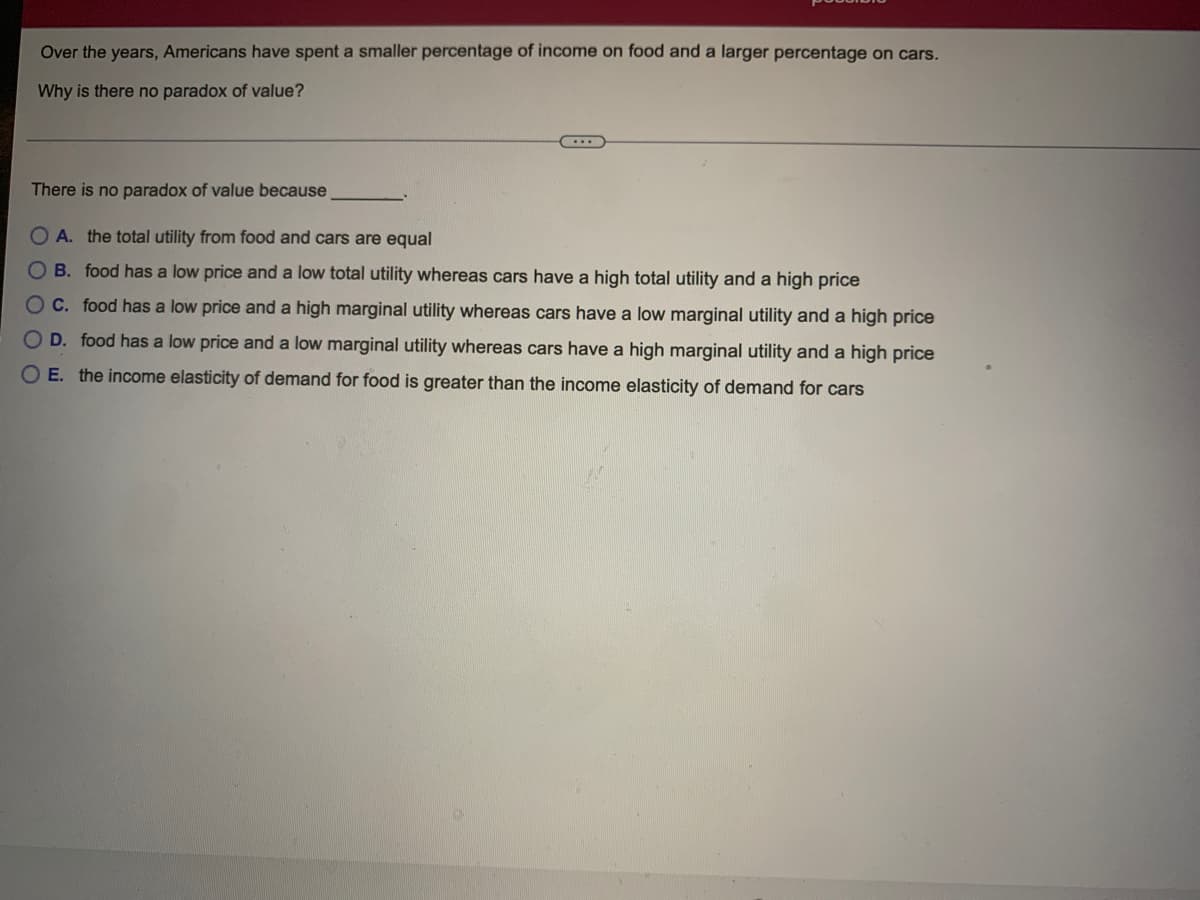Over the years, Americans have spent a smaller percentage of income on food and a larger percentage on cars. Why is there no paradox of value? C.. There is no paradox of value because O A. the total utility from food and cars are equal O B. food has a low price and a low total utility whereas cars have a high total utility and a high price Oc. food has a low price and a high marginal utility whereas cars have a low marginal utility and a high price OD. food has a low price and a low marginal utility whereas cars have a high marginal utility and a high price O E. the income elasticity of demand for food is greater than the income elasticity of demand for cars
Over the years, Americans have spent a smaller percentage of income on food and a larger percentage on cars. Why is there no paradox of value? C.. There is no paradox of value because O A. the total utility from food and cars are equal O B. food has a low price and a low total utility whereas cars have a high total utility and a high price Oc. food has a low price and a high marginal utility whereas cars have a low marginal utility and a high price OD. food has a low price and a low marginal utility whereas cars have a high marginal utility and a high price O E. the income elasticity of demand for food is greater than the income elasticity of demand for cars
Micro Economics For Today
10th Edition
ISBN:9781337613064
Author:Tucker, Irvin B.
Publisher:Tucker, Irvin B.
Chapter6: Consumer Choice Theory
Section: Chapter Questions
Problem 3SQP
Related questions
Question
Question 3

Transcribed Image Text:Over the years, Americans have spent a smaller percentage of income on food and a larger percentage on cars.
Why is there no paradox of value?
There is no paradox of value because
O A. the total utility from food and cars are equal
OB. food has a low price and a low total utility whereas cars have a high total utility and a high price
C. food has a low price and a high marginal utility whereas cars have a low marginal utility and a high price
OD. food has a low price and a low marginal utility whereas cars have a high marginal utility and a high price
O E. the income elasticity of demand for food is greater than the income elasticity of demand for cars
Expert Solution
This question has been solved!
Explore an expertly crafted, step-by-step solution for a thorough understanding of key concepts.
This is a popular solution!
Trending now
This is a popular solution!
Step by step
Solved in 2 steps

Knowledge Booster
Learn more about
Need a deep-dive on the concept behind this application? Look no further. Learn more about this topic, economics and related others by exploring similar questions and additional content below.Recommended textbooks for you


Microeconomics: Principles & Policy
Economics
ISBN:
9781337794992
Author:
William J. Baumol, Alan S. Blinder, John L. Solow
Publisher:
Cengage Learning



Microeconomics: Principles & Policy
Economics
ISBN:
9781337794992
Author:
William J. Baumol, Alan S. Blinder, John L. Solow
Publisher:
Cengage Learning


Exploring Economics
Economics
ISBN:
9781544336329
Author:
Robert L. Sexton
Publisher:
SAGE Publications, Inc

Principles of Economics 2e
Economics
ISBN:
9781947172364
Author:
Steven A. Greenlaw; David Shapiro
Publisher:
OpenStax
